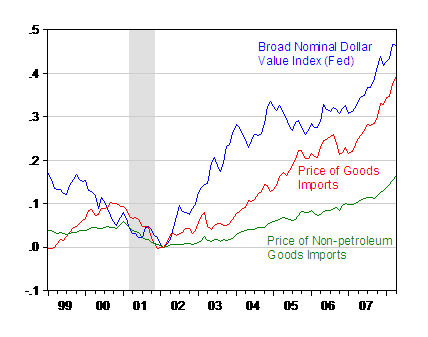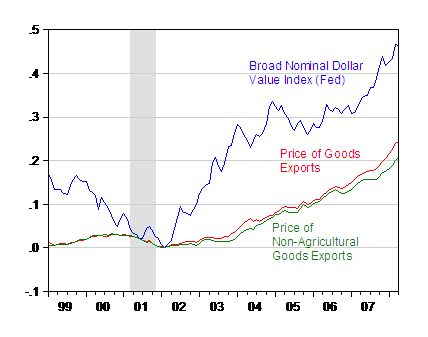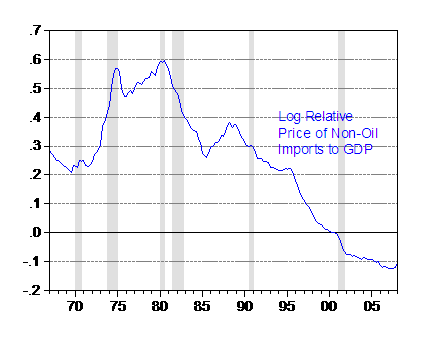The BLS’s Import/Export price release, from May 13th, might seem like old news. And some aspects are. But I think it is useful to think about what the trends in these price indices mean for general inflation and the adjustment process (this is in some sense an update on this post).
First, consider import prices.

Figure 1: Log dollar exchange rate (up is weaker) against broad basket of currencies (blue), log goods import price (red), log goods import ex-oil price (green), all normalized to 2002M02=0. Source: Federal Reserve Board via St. Louis Fed FREDII, BLS Export/Import price release (May 13), and author’s calculations.
Note that while total goods import prices (including commodities such as oil) have surged nearly 40% since 2002M02 — a remarkable 9/10 of the 45% depreciation of the broad trade weighted dollar over the corresponding period — the non-oil goods import price has only moved by a third of the dollar’s change. (This is why measured United States exchange rate pass-through is higher for prices including dollar-denominated commodities [1], [2]).
What does this mean? In particular, will these import price changes feed into a generalized change in the CPI? In a mechanical sense, they must since imported goods comprise some portion of the CPI. However, in an economic sense, they might not, to the extent that non-import prices fall.
Note that export prices have also risen. Figure 2 depicts the corresponding picture. Both the goods export and goods export ex-agriculture price indices have risen, accounting for between 4/5 and a half of the dollar’s depreciation. And while it is typical to focus on import prices as the key driver of domestic inflation, it is important to understand that as long as goods used in domestic consumption and exportables are to some degree substitutable, then rising export prices can also exert upward pressure on inflation. So while there is some appropriate focus on ethanol demand driving up food prices [3], to a certain extent the fact that US agricultural exports are demanded globally pulls upward domestic food prices.

Figure 2: Log dollar exchange rate (up is weaker) against broad basket of currencies (blue), log goods export price (red), log goods export ex-agricultural commodities price (green), all normalized to 2002M02=0. Source: Federal Reserve Board via St. Louis Fed FREDII, BLS Export/Import price release (May 13), and author’s calculations.
Returning to import prices, note that prices of imported goods from China have started rising substantially. Figure 3 depicts the time series for the USD/CNY nominal exchange rate and the price index for imports from China, normalized to 2005M06=0 (in logs). So, the long awaited adjustment of dollar prices to exchange rate changes appears to be underway.

Figure 3: Log USD/CNY exchange rate (up is weaker dollar) (blue), and log Chinese goods import price (red), all normalized to 2005M06=0. Source: Federal Reserve Board via St. Louis Fed FREDII, BLS Export/Import price release (May 13), and author’s calculations.
It is interesting that import prices kept on declining so long after the change in the Chinese exchange rate regime. The continued decline in the Chinese goods import price index suggests that productivity in Chinese export industries was increasing at such a substantial pace as to outweigh the combined effects of rising wages and appreciating yuan (although, without detailed knowledge on unit labor costs, one can’t be sure).
How to interpret the implications of these trends in tradable goods prices? First, it is important to observe that higher import and export prices need not necessarily lead to faster inflation. It could be that the exchange rate change and inflation are moving as a consequence of a common shock (namely monetary policy). In this interpretation, the correlation of exchange rate changes, import and export prices, and general price indices such as the CPI, are not structural. Estimation of pass-through equations with the CPI inflation rate on the left hand side then do not make sense.
On the other hand, if exchange rate changes are to some extent exogenous, then estimation of pass through equations might still make sense, especially to the extent that one can find valid instruments for those exchange rate changes.
I don’t want to focus on this particular issue (I’ve discussed this elsewhere [4]). Rather, I want to highlight the fact that the relative price of non-oil imports, as compared to the full basket in the CPI or the Core CPI, has essentially reversed trend.

Figure 4: Log ex-oil goods imports price relative to CPI (blue), and relative to Core CPI (red). Source: Federal Reserve Board via St. Louis Fed FREDII, BLS Export/Import price release (May 13), and author’s calculations.
In Figure 4, one will note that from 1990 to the beginning of 2008, the price of non-oil goods imports was declining relative to the total bundle in the CPI. Relative to the Core CPI, the price was declining until about the beginning of 2002. The relative price trend was essentially flat until the beginning of 2008.
The longer horizon movements are shown in Figure 5, which depicts the NIPA measure of non-oil goods imports prices relative to the GDP deflator. While the slope of the trend is somewhat different over the 1990-2008 period, the same essential result shows up — that recent months have a seen a radical break in the relative price.

Figure 5: Log ex-oil goods import price relative to GDP deflator (blue). NBER defined recessions shaded gray. Source: BEA GDP release of April 30, 2008, NBER, and author’s calculations.
What remains to be seen is whether this recent trend is extended, so that something like the mid-1980’s episode is replicated; at that time, the non-oil net exports deficit shrank by about 2 percentage points of GDP before the recession of 1990 set in.
Technorati Tags: trade deficit,
import pricess,
export prices, pass through,
dollar, expenditure switching,
monetary policy,
tradables.
Figure 5 is great, but I would like to see it with both import prices and the gdp deflator excluding both food and energy.
Menzie wrote:
And while it is typical to focus on import prices as the key driver of domestic inflation, it is important to understand that as long as goods used in domestic consumption and exportables are to some degree substitutable, then rising export prices can also exert upward pressure on inflation.
Menzie,
If I were to take just this sentence I would have to say that the analysis is totally backward. Imports do not cause inflation, inflaton causes an increase in the price of imports. But as I read the rest of your post it seem that you realize this but do not state it clearly. Am I right or wrong on this?
I assume that here you are actually saying that if imports are higher in price the US monetary authorities are making more mistakes on the inflation side than the rest of the world and that does seem to be the case. It also seems to be true that with China their movement toward a market based economy is strengthening their currency and their exports to the US even though the US is trying to get them to manipulate their currency prices to counter this – actually a whitewash painted over declining US economic strength to give the illusion of actual strengthening in the US economy.
You state, The continued decline in the Chinese goods import price index suggests that productivity in Chinese export industries was increasing at such a substantial pace as to outweigh the combined effects of rising wages and appreciating yuan (although, without detailed knowledge on unit labor costs, one can’t be sure). This does suggest that compared to China the US is declining economically and that should be alarming to our congress but they seem totaly oblivious to the damage they are doing to our economy. As China relaxes their central planning controls the US increases central planning controls and the result is clearly manifest in both the fiscal and monetary situation.
I would like to get into how wonderfully figure 5 demonstrates the importance of supply side policies but that is another discussion.
are you using the fed’s nominal or real broad dollar index?
spencer: To my knowledge, the GDP deflator on a quarterly basis is not reported in a form that allows me to strip out energy and food components.
DickF: The rate of change in import and CPI prices might be driven by common shocks (say monetary policy shocks). To the extent that they are common, higher import prices do not result in higher CPI inflation. However, suppose there is an exogenous shock to desired holdings of dollar denominated assets. This will cause a decrease in the dollar’s values separate from monetary policy, and might then induce an increase in import prices. Depending on the nature of the monetary policy regime (how much accomodation of price shocks, etc.), this might or might not manifest itself in inflationary pressure. The more monetary policy targets a price level , rather than a inflation rate, the more likely the import price change manifests itself in a relative price change.
glory: While not in the Notes to the figures, the legends in the figures themselves indicate use of nominal exchange rates in Figures 1-3.
Could the leveling-off in Figure 4 be explained by the following two speculations?
1) Chinese exporters being happy to quote prices in USD while it was appreciating but less happy to do so when it begun depreciating. This would lead to an asymmetric pass-through of exchange rate shocks (ERPT increases during USD depreciations as the frequency of local-currency pricing declines)
2) Increase in the degree of substitution between US and foreign goods ever since the Chinese export boom begun (a larger fraction of CPI is sensitive to import price changes).
Menzie,
You may be right that productivity in the Chinese export industries was increasing enough to outweigh the combined effects of rising wages and appreciating yuan. Technological progress in industries producing processed exports has been amazing in recent years.
The real question embedded in your analysis is why does the Fed expect inflation to moderate given the recent change in trend in non-oil import prices? True, import prices, and their larger derivative, tradeables prices, are not a huge component of CPI. However, with commodity prices rising, import prices rising, OER steady at around a .3% clip, why expect a decline in inflation? There seems to be no basis for it in fact or trends, other than the slope of the forward curve in commodity markets — a slope which recently has begun to trend up rather than down, at least for oil.
The truth is, the Fed’s “inflation will moderate” forecast will stand as long as the TIPS spread is in the same ballpark — its been the case the past three years, and its been wrong in each of those years. So much is staked upon a flawed measure of inflation expectations.
*blinks*
oh ok, don’t know why i didn’t see it there before 😛
thanks!
Martin Berka: Regarding supposition 1, I’m dubious that invoicing currency choice is so time-variable. However, Goldberg and Tille (2008) is the best reference on the empirics, so I’d consult that paper.
On suppostion 2, this might be true but I’m not aware of any empirical work that discerns this effect for the 2002- period. I’m inclined to think that the leveling off has to do with the sustained decine in the dollar against the broad basket of currencies.
David Pearson: While we have inflationary pressures coming from commodity prices (including oil), we also have disinflationary pressures coming from a weakening (or weak — take your pick) real economy and slackening labor market. So a lot rides on one’s view on the elasticity of inflation with respect to the output gap.
Menzie wrote:
DickF: The rate of change in import and CPI prices might be driven by common shocks (say monetary policy shocks). To the extent that they are common, higher import prices do not result in higher CPI inflation. However, suppose there is an exogenous shock to desired holdings of dollar denominated assets. This will cause a decrease in the dollar’s values separate from monetary policy, and might then induce an increase in import prices.
Sorry but the whole idea of shocks is just a way of saying I don’t know what it is but it might happen. Speaking of a “shock,” while popular in modern economics, is actually speaking of an undefined imagination. I would rather have specifics or at least examples of what you mean by “shock.”
Depending on the nature of the monetary policy regime (how much accomodation of price shocks, etc.), this might or might not manifest itself in inflationary pressure.
Yes, there are economic events that can change monetary demand that the monetary authorities cannot see and so they can accidentally make it worse or better but if the monetary authorities had a tool that would tell them about such changes they they could actually make decisions that would always help the situation. Because they are always looking in the rearview mirror they have no idea what they are driving into only what they hit in the past.
The more monetary policy targets a price level , rather than a inflation rate, the more likely the import price change manifests itself in a relative price change.
I would prefer inflation rate targeting over price level targeting, but there is an even better tool. If the monetary authorities targeted a stable price of gold then other goods and services could change price depending on their supply and demand and the authorities would also see changes in demand reflected in a change in the price of gold and could then act to stabilize the currency. Gold, being a leading indicator would take them away from the rearview mirror and allow them to look through the windshield.
Menzie,
thank you for your reply and the reference. I agree with your suspicion about the volatility of the invoicing currency over time. On a second thought, I think that a change in the invoicing currency is not necessary for the story to hold. Assuming for the moment that (some) exporters keep pricing in the local currency (USD), as long as USD was appreciating, exporters found it profitable not to pass-through the ER movement into import price. When USD begun to depreciate, (Chinese) exporters would have found it advantageous to pass some of the ER movement into their export price to protect the markups – this could be the source of the delayed upswing in the price of Chinese exports in your Figure 3 (Bugameli and Tedeshi (2008) find robust evidence of exactly this type of asymmetric ER pass-through in the EU data, 1990-99).